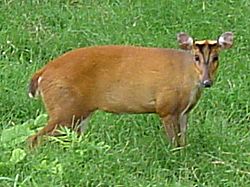Muntjac facts for kids
Quick facts for kids Muntjac |
|
|---|---|
 |
|
| Scientific classification | |
| Kingdom: | |
| Phylum: | |
| Class: | |
| Order: | |
| Suborder: | |
| Family: | |
| Subfamily: |
Muntiacinae
|
| Genus: |
Muntiacus
Rafinesque, 1815
|
Muntjac are small deer that belong to the Muntiacus group. People also call them Barking Deer because of the loud sounds they make. These deer are very old! Scientists have found their remains from 15 to 35 million years ago in places like France and Germany.
Today, you can find Muntjac in Southeast Asia. They live in countries like India, Sri Lanka, southern China, Taiwan, Japan, and the islands of Indonesia.
Contents
What Do Muntjac Look Like?
Muntjac are small deer. They live in warm, tropical areas. Unlike many other deer, they don't have a special mating season. This means they can have babies at any time of the year. Even the Muntjac that live in cooler countries still follow this pattern.
Male Muntjac have short antlers that can grow back if they fall off. But they often use their "tusks" to fight for their territory. These tusks are actually long, downward-pointing canine teeth. This is a special feature that helps tell them apart from other deer.
Muntjac in the United Kingdom
Some Muntjac, especially the Reeves's muntjac, were brought to the United Kingdom. They escaped from a place called Woburn Abbey around 1925. Now, many wild Muntjac live there. They have spread very quickly across most parts of England and even into Wales.
Experts think that Muntjac might soon become the most common type of deer in England. They have even been seen in Scotland and Ireland.
Muntjac and Their Genes
Scientists are very interested in Muntjac because of their amazing chromosome differences. Chromosomes are like tiny packages inside every living thing that carry all the instructions for how it grows.
The Indian muntjac (M. muntjak) has the fewest chromosomes of any mammal! Males have only 7 chromosomes, and females have just 6. But the Reeves's muntjac (M. reevesi) has 46 chromosomes. This huge difference between species is very interesting for scientists studying how animals change over time.
Types of Muntjac
There are 12 different types of Muntjac deer known today:
- Indian muntjac or common muntjac or kakar, Muntiacus muntjak
- Reeves's muntjac or Chinese muntjac, M. reevesi
- Hairy-fronted muntjac or black muntjac, M. crinifrons
- Fea's muntjac, M. feae
- Bornean yellow muntjac, M. atherodes
- Roosevelt's muntjac, M. rooseveltorum
- Gongshan muntjac, M. gongshanensis
- Giant muntjac, M. vuquangensis
- Truong Son muntjac M. truongsonensis
- Leaf muntjac M. putaoensis
- Sumatran muntjac M. montanus
- Pu Hoat muntjac M. puhoatensis
Images for kids
See also
 In Spanish: Muntíacos para niños
In Spanish: Muntíacos para niños





